Hunstanton
Hunstanton is a seaside town in Norfolk, England, which had a population of 4,229 at the 2011 Census.[1] It faces west across The Wash, making it one of the few places on the east coast where the sun sets over the sea. Hunstanton lies 102 miles (164 km) north-north-east of London and 40 miles (64 km) north-west of Norwich.[2]
| Hunstanton | |
|---|---|
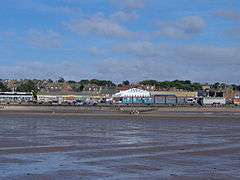 View of Hunstanton front from the beach | |
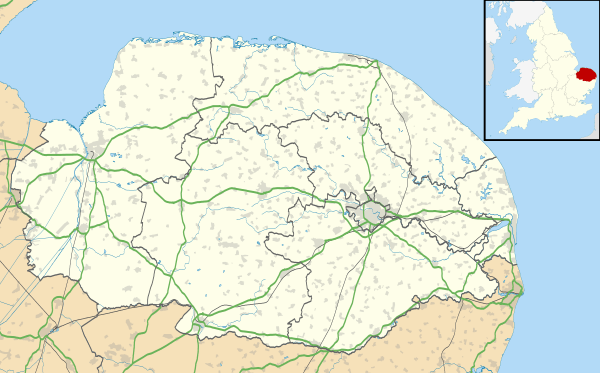 Hunstanton Location within Norfolk | |
| Area | 6.07 km2 (2.34 sq mi) |
| Population | 4,229 (2011) |
| • Density | 697/km2 (1,810/sq mi) |
| OS grid reference | TF6740 |
| District | |
| Shire county | |
| Region | |
| Country | England |
| Sovereign state | United Kingdom |
| Post town | HUNSTANTON |
| Postcode district | PE36 |
| Dialling code | 01485 |
| Police | Norfolk |
| Fire | Norfolk |
| Ambulance | East of England |
| UK Parliament | |
Governance
The Hunstanton electoral ward belongs to the Borough Council of King's Lynn and West Norfolk.[3] Its 2011 population was 5,420.[4] Hunstanton has a mayor and a 17-member town council that meets twice a month.[5]
Geology
The coastal cliffs include the type section of the Hunstanton Formation of lower reddish limestone, which was laid down during the Lower Cretaceous. This is topped by a white chalk layer from the Upper Cretaceous period.[7]
History

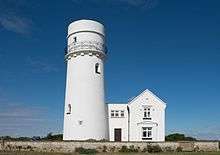
Hunstanton is a 19th-century resort town, initially known as New Hunstanton to distinguish it from the adjacent village from which it took its name. The new town soon exceeded the village in scale and population.
The original settlement, now Old Hunstanton, probably gained its name from the River Hun, which runs to the coast just to the east. It has also been argued that the name originated from "Honeystone", referring to the local red carr stone. The river begins in the grounds of Old Hunstanton Park, which surrounds the old moated hall, the ancestral home of the Le Strange family. Old Hunstanton village is of prehistoric origin and lies near to the head of Peddars Way. In 1970, evidence of Neolithic settlement was found. The quiet character of the village remains distinct from its busy sibling and complements it with clifftop walks past a redundant lighthouse and the ruins of St Edmund's Chapel, built in 1272.
In 1846, Henry Styleman Le Strange (1815–1862),[8] decided to develop the area south of Old Hunstanton as a bathing resort. He brought a group of like-minded investors into the construction of a railway line from King's Lynn. In 1861, Le Strange, as principal landowner, became a director of the railway company and by 1862 the line had been built. Le Strange died in the same year, at the age of 47, leaving his son Hamon to reap the rewards of his efforts. The Lynn and Hunstanton Railway became one of the most consistently profitable in the country.
Le Strange moved the ancient village cross from Old Hunstanton to a new site in 1846. In 1848 the first main building, the Royal Hotel (now the Golden Lion), was built by Victorian architect, William Butterfield, a friend of Le Strange. Overlooking a sloping green and the sea, and for several years standing alone, it earned the nickname "Le Strange's Folly". In 1850 Le Strange, an amateur architect and painter, appointed a land agent to survey the site and prepare a plan. Le Strange drew and painted a map and a perspective of the scheme, showing shops, a station and a church. He consulted William Butterfield on the design. Their shared passion was for an "Old English" style of architecture for domestic buildings, owing much to medieval precedents and the earnest Victorian Gothic Revival. Hunstanton came to exemplify a 19th-century estate seaside town. Most of the fabric and character of that development survives.
In 1915, during the First World War, Hunstanton was the headquarters of the West Norfolk training programme of the Queen's Own Cameron Highlanders, as they prepared for active service in France.[9]
Hunstanton was hit badly by the North Sea Flood of 1953. The wall of water on the night of 31 January – 1 February killed 31 people, 16 of them American servicemen and their families. There were 35 more victims in neighbouring Snettisham and Heacham.[10]
Notable people
In birth order:
- Edmund the Martyr (died 869), King of East Anglia, landed here to claim his kingdom about 855.
- Sir Roger L'Estrange (1616–1704), Royalist and pamphleteer, was born here.
- Guy Le Strange (1854–1933), Middle East scholar and linguist, was born here.
- George Grundy (1859–1945), first-class cricketer, died here.
- Tiverton Preedy (1863–1928), Anglican cleric and sports promoter, was born here.
- Clara Dow (1883–1969), operatic soprano and actress, made her stage début here in 1899.
- Robert Herring MC (1897–1973), an officer in the British Army and RAF in both World Wars, was born here.
- Reis Leming (1930–2012), US airman, received the UK George Medal for rescuing 27 people from South Beach during the North Sea flood of 1953.
- Richard Greer (born 1946), motorcycle speedway rider in the 1970s and 1980s, lives here.
- Bill Alexander (born William Alexander Paterson, 1948), theatre director, was born here.
Tourism

Hunstanton's summer crowds are smaller than in the 1980s, although its relative popularity with day-trippers and holidaymakers has endured, despite the decline in British seaside holidaying. Businesses in villages south of Hunstanton (Dersingham, Ingoldisthorpe and Snettisham) complained in the 1990s of a loss in trade after being bypassed by the A149 to Hunstanton.
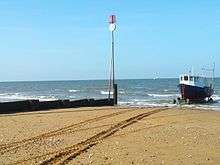
.jpg)
The town has several Victorian squares. Boston Square provides a view across the Wash to Boston, Lincolnshire where Boston Stump is visible on clear days.
Hunstanton has a fairground, aquarium and seal sanctuary, leisure pool, theatre, large caravan parks with amenities (Searle's Holiday Park opened in 1936), some amusement arcades, and a long promenade. The centrepiece remains the large sloping green from one end of High Street to the promenade.
The town once had a Victorian pleasure pier, with a pavilion and miniature steam railway. The pier pavilion was destroyed by fire in 1939, the pier was damaged by fire again in the 1950s, before almost the entire structure was washed away by a storm in 1978. What remained extended just 15 feet out from the amusement arcade and cafe built on the site of the original entrance. In 2002, the entire building, with the remains of the pier, was destroyed in a fire. The building was too badly damaged for the cause to be determined. Today, the site is occupied by an arcade and bowling alley complex. The pier featured in the 1957 Ealing Studios comedy film Barnacle Bill (released in the US as All at Sea) starring Alec Guinness.
Hunstanton has markets on Wednesdays and Sundays selling fresh fish and fresh fruit and vegetables attract greater visitor numbers in the summer months through to the autumn. The main shopping streets have stone buildings, some with glazed canopies, evoking the Victorian and Edwardian eras of their construction.
In good weather, excursion boats take visitors out to view grey and common seals that have colonised sand bars in the Wash and to the north of Norfolk. The countryside around Hunstanton is hillier than most of Norfolk and sparsely populated, the only large settlement nearby is King's Lynn, 12 miles (19 km) to the south.
Transport
The town is linked to King's Lynn by a frequent Lynx bus service. Other services run to Sandringham, Wells-next-the-Sea, Sheringham and Cromer.[11]
Hunstanton railway station offered services to King's Lynn until 1969, when the line was closed as uneconomic.
Education
The Smithdon High School (formerly Hunstanton Secondary Modern School) is an early building designed by the architects Peter and Alison Smithson, built in 1949–1954 in a radical style of international architectural significance. It is a Grade II* listed building.[12]
The school epitomised architectural experiment in post-war Britain and growing acceptance of modernism by public authorities. It was praised for an intelligent layout and formal elegance.[13] The Smithsons deliberately left many of the service elements of the school exposed, making a feature of the water tank by turning it into a tower. The disposition, steel frames and panels of brick and glass echo the work of Mies Van Der Rohe at the Massachusetts Institute of Technology.[14]
Hunstanton is home to Glebe House School, an independent co-educational preparatory school.
Theatre, cinema and culture
The Princess Theatre is a 472-seat venue open all year round for a variety of shows from comedy to drama, music for all tastes, and children's productions. The venue also has a six-week summer season and an annual Christmas pantomime. Films are screened in the week. Opened as the Capitol Cinema in 1932, it is noted for its Norfolk carr stone construction, of which it contains the largest gable wall in existence. It was designed as a theatre as well as a cinema, but closed in the 1960s and was sold in 1974. It reopened as the Kingsley Centre for summer seasons and films for about two years, but declined into a bingo hall before closing again. The Borough Council of King's Lynn and West Norfolk purchased it in 1981, and in honour of Lady Diana Spencer who married the Prince of Wales in July 1981, it was renamed the Princess Theatre and officially re-opened on 5 July 1981.
Hunstanton Concert Band plays in and around Hunstanton at a wide variety of venues including churches, fêtes, concerts and the town's bandstand. The Deaf Havana album Fools and Worthless Liars featured a track called "Hunstanton Pier", a nostalgic recollection of the town where James Veck-Gilodi, its lead singer, grew up.
Literary associations
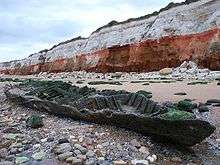
Between the world wars, P. G. Wodehouse often visited his friend Charles Le Strange at Hunstanton Hall. It influenced a number of locations in his comic novels, as Aunt Agatha's country seat Woollam Chersey and the inspiration for the setting for Money for Nothing (1928). The octagon in the garden featured in "Jeeves and the Impending Doom". Norfolk also furnishes names for many of Wodehouse's characters, such as Brancaster, Jack Snettisham and J. Sheringham Adair.
L. P. Hartley knew the Hunstanton neighbourhood from childhood holidays and used it as a setting for The Shrimp and the Anemone (1944), the first novel in his Eustace and Hilda trilogy. It is at Hunstanton Hall, fictionalised as Anchorstone Hall, that Eustace enters the privileged world of the aristocracy and eventually inherits a small fortune. The layered cliffs at Hunstanton (consisting of chalk, red chalk and carr stone) provide a backdrop for Eustace and Hilda's games among the rock pools.
Patrick Hamilton's novel Hangover Square opens with George Harvey Bone walking on the cliffs in Hunstanton. Hamilton lived for many years at Martincross in Sheringham and spent time in the 1930s in a cottage in Burnham Overy Staithe, with his first wife, Lois.
Sport

Hunstanton attracts thousands during a week in August, for the ITA Hunstanton Lawn Tennis tournament (the biggest in England after Wimbledon) inaugurated in 1920. All ages can play from the young (Under 8 Round Robin) to senior veterans. Apart from the tournament, it is a big social event.
Hunstanton Golf Club, founded in 1891 by Hamon Le Strange, is an 18-hole championship links along the sandy coast of Old Hunstanton. It has a classic "out and back" design on either side of a central spine or dune ridge. The 12th, 13th and 14th holes play across the ridge.
The town has hosted several international sporting events, including the 2005 World Water Ski Racing Championships.
References
- "Town population 2011". Retrieved 28 August 2015.
- UK preferences. Retrieved 27 January 2019.
- Borough site Retrieved 4 December 2016.
- "Ward population 2011". Retrieved 28 August 2015.
- Council site Retrieved 4 December 2016. Archived 18 October 2016 at the Wayback Machine
- anonymous (2018). Hunstanton Guide Book. Hunstanton & District Civic Society.
- "Hunstanton Formation". British Geological Survey.
- Source: Hunstanton Civic Society
- Mary Mackie: Hunstanton's Highland Heroes: West Norfolk 1915 (King's Lynn: Morningside Publishers, 2018) ISBN 0-95759-782-7.
- Eastern Daily Press memorial issue, 1 February 2013 Retrieved 8 September 2018.
- "Bus times from King's Lynn to Hunstanton from Lynxbus". Lynx. Retrieved 27 September 2016.
- Archived 21 May 2013 at the Wayback Machine
- "Hunstanton School – Data, Photos & Plans – WikiArquitectura".
- "Revisiting Alison and Peter Smithson's Hunstanton school".
External links
| Wikivoyage has a travel guide for Hunstanton. |
| Wikimedia Commons has media related to Hunstanton. |
